![]()
![]()
![]()
Use LEFT and RIGHT arrow keys to navigate between flashcards;
Use UP and DOWN arrow keys to flip the card;
H to show hint;
A reads text to speech;
31 Cards in this Set
- Front
- Back
|
Eyes deviate towards side of lesion in ______ and away from side of lesion in ________.
|
stroke - eyes go towards side of lesion
seizure - eyes go to side away from side of lesion |
|
|
A lesion to which part fo the brain would cause the following signs:
• Agnosia – Denial of functional loss – Face recognition • Neglect – Sensory extinction – Visual inattention/extinction • Apraxia – Constructional – Dressing |
Non-dominant parietal lobe
|
|
|
A lesion to which part of the brain would cause the following signs:
• Gerstmann syndrome – Left-Right disorientation – Dyscalculia – Dysgraphia – Finger naming • Apraxia – Ideomotor – Ideational |
Dominant parietal lobe
|
|
|
A lesion to which part of the brain would cause the following signs:
• Deficits – Unable to follow command (may be limited) – Fluent but meaningless speech – Appear oblivious of any deficit • Paraphasias – Phonemic ‘The cat sat on the mal’ – Semantic ‘The cat sat on the dog’ – Neologism ‘This building is a herpidag’ – Word salad or gibberish |
Wernicke's area (temporal lobe)
|
|
|
A lesion to which part of the brain would cause the following signs:
– Can follow command (may be limited) – Non-fluent (frustrated) speech – Limited repertoire (swearing, yes, no) |
Broca's area (frontal lobe)
|
|

|
PCA infarct
|
|
|
What functional areas would be affected by ischaemia in the ACA-MCA border zone?
|
- Hip, shoulder (less typically arm) region or primary motor or somatosensory cortex
- Areas related to language production (in dominant hemisphere) - Frontal eye fields - Frontal lobe motor planning area |
|
|
What functional areas would be affected by ischaemia in the ACA/MCA-PCA border zone?
|
- Optic radiations
- Inferior temporal lobe cortex (important for visual/spacial/facial recognition) - Language comprehension, word finding in dominant hemisphere - Parietal lobe visuospatial perceptions |
|

|
A. ACA
B. MCA C. MCA D. Anterior perforated substance E. Boundary/watershed of ACA and MCA |
|

|
A. ICA
B. Cavernous sinus C. Superior petrosal sinus D. Superior sagittal sinus E. Transverse sinus |
|
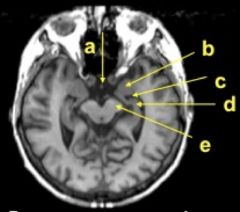
|
A. Pituitary gland
B. Amygdala C. Anterior horn of lateral ventricle D. Hippocampus E. Cerebral peduncle |
|
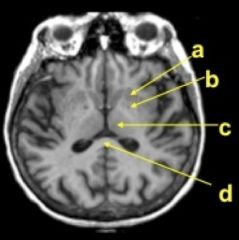
|
A. Putamen
B. Globus pallidus C. Thalamus D. Splenium of corpus callosum |
|
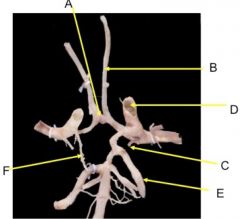
|
A. Anterior communicating artery
B. ACA C. AChA D. ICA E. PCA F. Posterior communicating artery |
|
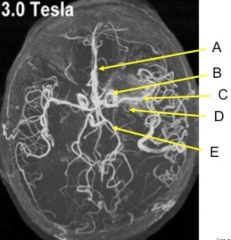
|
A. ACA
B. Internal carotid (siphon) C. MCA stem D. AChA (anterior choroidal artery) E. PCA |
|
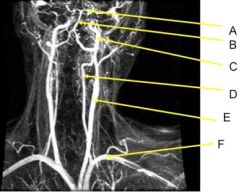
|
A. PCA
B. Basilar artery C. Internal carotid D. Vertebral artery E. Common carotid artery F. Subclavian artery |
|
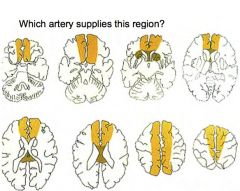
|
ACA
|
|

|
MCA
|
|
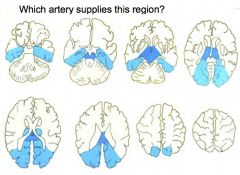
|
PCA
|
|
|
What is the normal range of intracranial pressure?
|
0-15 mmHg
|
|
|
How are brain tumours diagnosed?
|
- Cranial MRI with contrast injection (if MRI negative, essentially rules out brain tumour)
- Diagnosis must be confirmed by histological examination - PET can help distinguish high/low grade tumours |
|
|
What cell type do meningiomas arise from?
|
Arachnoid cells
|
|
|
How do meningiomas appear on microscopy?
|
Whorls of cells
|
|
|
- Loss of ability to accommodate associated with ageing and usually strikes in the 50s
- Major contributor is the loss of lens flexibility so that it cannot change its curvature |
Presbyopia
|
|
|
What is the most common long- term complication (particularly with pediatric cataract surgery)
|
Posterior Capsule opacification (PCO) - epithelial cell proliferation, migration and fibrosis
(Followed by glaucoma and late-age related maculopathy) |
|
|
Is the aura associated with migraine associated with changes in neural firing or changes in blood flow?
|
Neural firing
|
|
|
Damage to WHICH cortex can result in the loss of ability to alter response when input changes – decision maker for appropriate movement. It may also result in:
- difficulty going for the big picture; attention only to details. - They laugh or cry inappropriately - trouble with working memory – temporary data storage |
Prefrontal association cortex
|
|
|
Extensive damage to WHICH cortex can result in conditions such as:
• finger agnosia (inability to recognize different fingers) • agraphia (inability to write) • alexia (inability to read) • dyscalculia ( decreased ability to calculate or use numbers) • left-right confusion • disturbances in the awareness of body image |
The parietal association cortex
|
|
|
Damage to which cortex causes contralateral neglect syndrome?
(Patients bump into objects on contralateral side of lesion May not groom contralateral body May not eat food on side opposite to lesion The patients receive sensory information from the contralateral side of the body but they simply neglect it.) |
Parietal association cortex
|
|
|
Extensive damage to WHICH cortex can result in changes in emotional processing. For example, damage has been reported to result in a patient being able to “feel” and accurately localize painful stimuli but the pain does not bother them.
|
Limbic association cortex
|
|
|
How to assess likelihood of stroke after a TIA
|
ABCD2 Score
- Age 60 years or older (1) - BP elevated on first assessment after TIA (systolic >140, diastolic >90) (1) - Clinical features of TIA (unilateral weakness = 2, speech impairment without weakness = 1) - Duration of TIA (>60m = 2, 10-59m = 1) - Diabetes (1) |
|
|
What is the most likely vascular territory involved in a TIA with left arm and leg weakness and slurring of speech?
|
Right MCA territory
|

